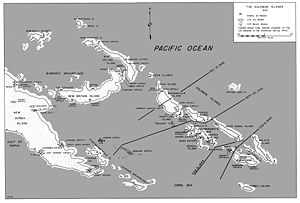The Solomon Islands campaign was a major campaign of the Pacific War of World War II. The campaign began with Japanese landings and capture of several areas in the British Solomon Islands and Bougainville, in the Territory of New Guinea, during the first six months of 1942. The Japanese occupied these locations and began the construction of several naval and air bases with the goals of protecting the flank of the Japanese offensive in New Guinea, establishing a security barrier for the major Japanese base at Rabaul on New Britain, and providing bases for interdicting supply lines between the Allied powers of the United States and Australia and New Zealand.
The Allies, to defend their communication and supply lines in the South Pacific, supported a counteroffensive in New Guinea, isolated the Japanese base at Rabaul, and counterattacked the Japanese in the Solomons with landings on Guadalcanal (see Guadalcanal campaign) and small neighboring islands on 7 August 1942. These landings initiated a series of combined-arms battles between the two adversaries, beginning with the Guadalcanal landing and continuing with several battles in the central and northern Solomons, on and around New Georgia Island, and Bougainville Island.
In a campaign of attrition fought on land, at sea, and in the air, the Allies wore the Japanese down, inflicting irreplaceable losses on Japanese military assets. The Allies retook some of the Solomon Islands (although resistance continued until the end of the war), and they also isolated and neutralized some Japanese positions, which were then bypassed. The Solomon Islands campaign then converged with the New Guinea campaign.
Cite error: There are <ref group=lower-alpha> tags or {{efn}} templates on this page, but the references will not show without a {{reflist|group=lower-alpha}} template or {{notelist}} template (see the help page).
